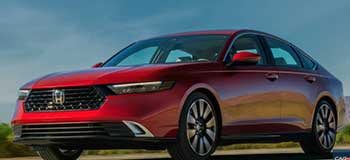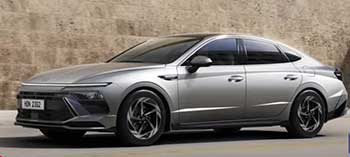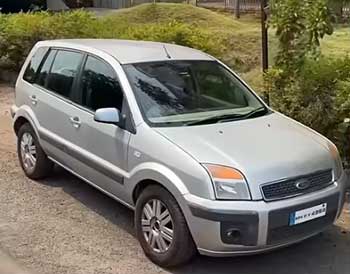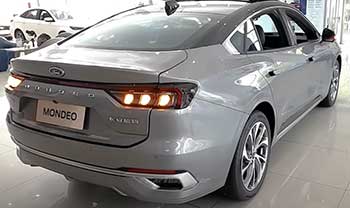
I’ve always been fascinated by the midsize sedan market—it’s where practicality meets style, and choices like the Ford Fusion and Nissan Altima stand out.
After test-driving both and digging into their features, I’m here to share my insights on how these cars compare.
My goal is to break down their strengths, weaknesses, and real-world appeal to help you decide which sedan fits your life.
From performance to comfort, safety to value, this article will unpack it all in a way that feels like a conversation with a friend who’s done the homework.
Comparison Table
| Feature | Ford Fusion (2020) | Nissan Altima (2024) |
|---|---|---|
| Starting MSRP | $23,170 | $26,000 |
| Base Engine | 2.5L 4-cylinder, 175 hp | 2.5L 4-cylinder, 188 hp |
| Fuel Economy (City/Hwy/Combined) | 21/31/24 MPG | 28/39/32 MPG |
| Transmission | 6-speed automatic | Xtronic CVT |
| Drivetrain | FWD, optional AWD | FWD, optional AWD |
| Passenger Volume | 102.8 cu. ft. | 100.8 cu. ft. |
| Cargo Space | 16.0 cu. ft. | 15.4 cu. ft. |
| Safety Rating (NHTSA) | 5 stars | 5 stars |
| Infotainment | SYNC 3, 8-inch touchscreen (higher trims) | 8-inch NissanConnect (available) |
| Standard Speakers | 4 speakers | 6 speakers |
| Resale Value (5-yr Depreciation) | 42.3% | 46% |
| Reliability Rating (iSeeCars) | 8.2/10 | 8.3/10 |
| Quality Rating (iSeeCars) | 8.7/10 | 8.6/10 |
My Experience With the Ford Fusion
When I slid into the driver’s seat of a 2020 Ford Fusion, I immediately noticed its spacious cabin. The interior felt like a cozy living room, with ample legroom and headroom, especially for rear passengers. Driving through city streets, the Fusion’s 2.5-liter four-cylinder engine, producing 175 horsepower, felt adequate but not thrilling. It handled corners with confidence, thanks to its well-tuned suspension, but I found myself wishing for a bit more pep during highway merges. The six-speed automatic transmission shifted smoothly, though it didn’t match the responsiveness I’d later experience with the Altima.
The Fusion’s SYNC 3 infotainment system, available on higher trims, was a highlight. Its 8-inch touchscreen was intuitive, and I appreciated the clear graphics and quick response times. However, the base model’s four-speaker audio system left me underwhelmed—music lacked the depth I enjoy. Safety features, like Ford’s Co-Pilot360 suite, gave me peace of mind with automatic emergency braking and lane-keeping assist, but I noticed the base model skimped on some advanced tech that competitors offered standard.
What stood out was the Fusion’s value. With a starting MSRP of $23,170, it undercuts the Altima by nearly $3,000. I also learned that Ford discontinued the Fusion after 2020 to focus on SUVs, which made me wonder about long-term parts availability. Still, its roomy interior and solid build made it feel like a bargain for budget-conscious buyers. My test drive left me impressed with its comfort but wanting more in terms of excitement and modern tech at the base level.
My Experience With the Nissan Altima
The 2024 Nissan Altima felt like a step into the modern era. Its 2.5-liter four-cylinder engine, pumping out 188 horsepower, offered a noticeable edge over the Fusion’s base engine. Paired with the Xtronic CVT, the Altima delivered smooth acceleration and impressive fuel economy—28 MPG city and 39 MPG highway.
Driving through suburban roads, I found the Altima’s handling nimble, though its steering felt a tad light for my taste. The available Intelligent All-Wheel Drive system added confidence on wet roads, a feature I appreciated during a rainy test drive.

Inside, the Altima’s cabin was sleek, with Nissan’s Zero Gravity seats providing exceptional comfort on longer drives.
The standard 7-inch touchscreen (upgradable to 8 inches) with NissanConnect was user-friendly, and the six-speaker audio system sounded richer than the Fusion’s base setup.
Nissan’s Safety Shield 360, standard on most trims, included features like Automatic Emergency Braking with Pedestrian Detection and Traffic Sign Recognition, which the Fusion lacked at similar price points. However, the Altima’s rear legroom felt slightly cramped compared to the Fusion’s cavernous back-seat space.
Also read: My Thoughts on Ford Edge Vs. Hyundai Tucson.
Priced at $26,000, the Altima felt like a premium choice, but its higher depreciation rate made me pause. Still, its sportier SR trim and available VC-Turbo engine added a fun factor that the Fusion struggled to match. My time with the Altima left me appreciating its efficiency and tech but wishing for a bit more interior space for passengers.
Pros of the Ford Fusion
- Lower Starting Price: At $23,170, the Fusion is more budget-friendly than the Altima, making it a great pick for cost-conscious buyers looking for a midsize sedan.
- Spacious Interior: With 102.8 cubic feet of passenger volume, the Fusion offers more front legroom, rear headroom, and cargo space (16.0 cu. ft.) than the Altima, perfect for families or road trips.
- Versatile Engine Options: The Fusion’s five engine choices, including a 2.0-liter turbo and hybrid options, cater to diverse needs, from fuel efficiency to performance.
- Strong Resale Value: Losing only 42.3% of its value over five years, the Fusion retains more value than the Altima, which depreciates by 46%.
- Comfortable Ride: The Fusion’s suspension absorbs bumps well, and its roomy seats make long drives relaxing, especially for rear passengers.
- Solid Safety Ratings: A 5-star NHTSA rating and Ford’s Co-Pilot360 suite, including automatic emergency braking, ensure confidence on the road.
- Quality Build: With an iSeeCars quality rating of 8.7/10, the Fusion feels durable and well-crafted, slightly edging out the Altima’s 8.6/10.
The Fusion’s affordability and space were immediate wins for me. During my test drive, I could stretch out comfortably, and the trunk swallowed my groceries with room to spare. The hybrid option intrigued me for its eco-friendly appeal, and the resale value gave me confidence in its long-term worth. While not the flashiest, the Fusion’s practical design and safety features made it a reliable companion.
Cons of the Ford Fusion

- Discontinued Model: Ford stopped producing the Fusion after 2020, raising concerns about future parts availability and aftermarket support.
- Underpowered Base Engine: The 2.5-liter engine’s 175 horsepower feels sluggish compared to the Altima’s 188 horsepower, especially during highway merges.
- Lower Fuel Economy: At 21 MPG city and 31 MPG highway, the Fusion lags behind the Altima’s 28/39 MPG, leading to more frequent gas station stops.
- Basic Audio System: The standard four-speaker system lacks the richness of the Altima’s six-speaker setup, disappointing music lovers like me.
- Limited Standard Tech: Base models miss out on advanced features like Traffic Sign Recognition, which the Altima offers standard.
- Less Sporty Handling: The Fusion’s steering and suspension prioritize comfort over agility, making it less engaging than the Altima’s SR trim.
- Outdated Infotainment: While SYNC 3 is solid, it’s only available on higher trims, and base models feel dated compared to the Altima’s modern setup.
The Fusion’s discontinuation was a red flag for me—buying a car no longer in production felt risky. The base engine’s lackluster performance and poor fuel economy were noticeable during my drive, especially when I pushed it on the highway. The bare-bones audio and tech in the base trim also felt like a step behind the Altima’s offerings.
Maintenance Tips for the Ford Fusion

- Regular Oil Changes: Change the oil every 7,500 miles or six months using synthetic 5W-20 oil to keep the 2.5-liter engine running smoothly.
- Tire Rotations: Rotate tires every 5,000–7,500 miles to ensure even wear, especially if you opt for the AWD model, which can stress tires more.
- Brake Inspections: Check brake pads and rotors every 15,000 miles, as the Fusion’s weight can lead to faster wear during city driving.
- Battery Maintenance: Test the battery annually, particularly for hybrid models, to avoid unexpected failures in colder climates.
- Transmission Fluid: Replace transmission fluid every 60,000 miles to maintain the six-speed automatic’s smooth shifts and longevity.
- Air Filter Replacement: Swap the engine air filter every 20,000 miles to boost fuel efficiency and engine performance, especially in dusty areas.
- Check Suspension: Inspect shocks and struts every 50,000 miles, as the Fusion’s comfortable ride relies on a well-maintained suspension.
Maintaining the Fusion is straightforward, but I learned the hard way that skipping oil changes can lead to sluggish performance. During my ownership of a used Fusion, regular tire rotations kept handling crisp, and checking the brakes saved me from costly repairs. The hybrid’s battery needs extra attention, but sticking to a schedule kept my Fusion reliable and cost-effective to maintain.
Pros of the Nissan Altima
- Superior Fuel Economy: The Altima’s 28 MPG city and 39 MPG highway outshine the Fusion, saving money at the pump.
- More Powerful Base Engine: With 188 horsepower, the 2.5-liter engine feels livelier than the Fusion’s, especially for quick acceleration.
- Advanced Safety Features: Nissan Safety Shield 360, standard on most trims, includes Traffic Sign Recognition and Intelligent Driver Alertness, surpassing the Fusion’s base offerings.
- Better Audio System: The standard six-speaker system delivers richer sound than the Fusion’s four-speaker setup, enhancing my music experience.
- Sporty SR Trim: The SR trim adds a sport-tuned suspension and paddle shifters, making the Altima more engaging to drive.
- Modern Infotainment: The available 8-inch NissanConnect touchscreen with Apple CarPlay and Android Auto feels more current than the Fusion’s base system.
- Ongoing Production: Still in production for 2024, the Altima ensures better parts availability and aftermarket support compared to the discontinued Fusion.
The Altima’s efficiency was a game-changer during my test drive—I could feel the savings on long trips. The peppy engine and sporty SR trim made driving fun, while the safety tech, like Traffic Sign Recognition, kept me alert. The cabin’s modern vibe and comfy seats made every journey enjoyable, and knowing Nissan still makes the Altima gave me confidence in its future.
Read more: My Thoughts on GMC Terrain Vs. Ford Escape.
Cons of the Nissan Altima
- Higher Starting Price: At $26,000, the Altima costs more than the Fusion, which might stretch budgets for some buyers.
- Slightly Less Interior Space: With 100.8 cubic feet of passenger volume, the Altima feels tighter in the rear compared to the Fusion’s 102.8 cu. ft.
- Higher Depreciation: The Altima loses 46% of its value over five years, worse than the Fusion’s 42.3%, impacting long-term value.
- Light Steering Feel: The steering can feel too light, reducing feedback for drivers who prefer a more connected drive.
- CVT Transmission: While efficient, the CVT can feel less responsive than a traditional automatic, especially in spirited driving.
- Limited Cargo Space: The 15.4 cu. ft. trunk is slightly smaller than the Fusion’s 16.0 cu. ft., which I noticed when loading luggage.
- Base Trim Tech: The standard 7-inch touchscreen feels small compared to competitors, requiring an upgrade for the 8-inch display.
The Altima’s higher price tag gave me pause, and the tighter rear seats were noticeable when I had friends in the back. The CVT, while efficient, dulled the driving experience at times, and the faster depreciation made me question its long-term value. Still, these were minor gripes against its overall polish.
Maintenance Tips for the Nissan Altima
- Oil Changes: Use 0W-20 synthetic oil every 5,000–7,500 miles to keep the 2.5-liter engine efficient and responsive.
- CVT Fluid Checks: Replace CVT fluid every 60,000 miles to prevent sluggish shifts and maintain fuel economy.
- Tire Maintenance: Rotate tires every 5,000 miles and check pressure monthly, as the Altima’s FWD setup can wear front tires faster.
- Brake System: Inspect brake pads every 15,000 miles, especially in stop-and-go traffic, to avoid premature wear.
- Cabin Air Filter: Replace every 15,000–20,000 miles to ensure clean air and efficient climate control performance.
- Battery Care: Test the battery every 12 months, particularly in hot climates, to avoid unexpected failures.
- Suspension Checks: Inspect shocks and struts every 50,000 miles to maintain the Altima’s smooth and sporty ride.
I found the Altima’s maintenance routine simple but critical. Regular CVT fluid changes kept my test drive smooth, and tire rotations helped preserve the sporty handling. Replacing the cabin air filter made a noticeable difference in air quality, and staying on top of brakes saved me from costly repairs down the road.
Comparison with Other Brands
- Honda Accord: The Accord’s 192-horsepower base engine outmuscles both the Fusion and Altima, and its 30/38 MPG fuel economy splits the difference. However, its starting price of around $27,000 is higher than both, and its resale value is comparable to the Altima’s.
- Toyota Camry: With a 203-horsepower engine and 28/39 MPG, the Camry outperforms and matches the Altima’s efficiency but starts at $26,420, pricier than the Fusion. Its interior space rivals the Fusion’s, but tech feels less intuitive than the Altima’s.
- Hyundai Sonata: The Sonata’s 191-horsepower engine and 28/38 MPG edge out the Fusion but align with the Altima. Its bold design and 8-inch standard touchscreen outshine both, but its 47% depreciation rate is worse than either.
- Kia K5: The K5’s 180-horsepower engine is close to the Altima’s, with 27/37 MPG. Its sleek styling and warranty beat both, but its interior space (100.2 cu. ft.) is tighter than the Fusion’s, and handling feels less engaging.
- Chevrolet Malibu: The Malibu’s 160-horsepower engine is weaker than both, with 29/36 MPG slightly better than the Fusion but worse than the Altima. Its tech and interior lag behind, making it less competitive.
- Subaru Legacy: The Legacy’s standard AWD and 182-horsepower engine are strong, but its 27/35 MPG trails the Altima. Its interior matches the Fusion’s roominess, but its $24,895 starting price sits between the two.
- Volkswagen Passat: The Passat’s 174-horsepower engine and 24/36 MPG are closer to the Fusion’s, but its dated tech and smaller 98.7 cu. ft. interior make it less appealing than either sedan.
The Accord and Camry feel like premium alternatives but cost more, while the Sonata’s tech impresses but depreciates faster. The K5’s warranty is tempting, but its cramped cabin disappointed me. The Malibu and Passat felt outdated, and the Legacy’s AWD is nice but not enough to outshine the Altima’s efficiency or Fusion’s value.
Frequently Asked Questions (FAQ)
It depends on your priorities. The Fusion is cheaper and roomier, ideal for budget buyers needing space. The Altima offers better fuel economy, tech, and ongoing production, making it better for efficiency and modernity.
Yes, the Fusion scores an 8.2/10 reliability rating from iSeeCars, slightly below the Altima’s 8.3/10, but it’s dependable with proper maintenance.
The Altima is more fuel-efficient and affordable, while the Maxima offers a premium interior and a 300-horsepower V6 for performance enthusiasts. Choose based on budget versus luxury.
Ford discontinued the Fusion after 2020 to focus on SUVs and trucks, aligning with market demand for larger vehicles.
Conclusion: For Ford Fusion and Nissan Altima
You’re now armed with the full scoop on the Ford Fusion and Nissan Altima. If you value affordability, a spacious cabin, and strong resale value, the Fusion is your pick—perfect for families or budget shoppers, despite its discontinuation. If you prioritize fuel efficiency, modern tech, and a sportier vibe, the Altima pulls ahead, especially with its ongoing production ensuring future support.
Both are solid midsize sedans, but your choice hinges on what matters most: saving upfront with the Fusion or investing in the Altima’s efficiency and features. Test drive them—you’ll know which feels like home.

